
Preppers’ interests in ways to protect a computer from EMPs is for good reason. While it’s impossible to beat the EMP protection of a paperback book or physical documents in general, there is certainly a place for computers and electronic information in any post-collapse world.
You could fit an entire library’s worth of information on a hard drive. More information than you could ever store in physical hard copies. This is the perfect solution for secondary resources of information, i.e. information that may or may not need after the apocalypse.
I advise preppers to have hard copies of the most important books, the books what will have the most valuable information on post-collapse survival. This includes medical information first and foremost: prescription drug guides, Where There Is No Doctor, etc.
Build a survival library shelf of physical books and then store as many digital resources as you can on a hard drive of some type so you can have them to access at some future date. We’re talking everything, everything you can imagine possibly needing after a collapse. Load it all onto a computer and then copy it onto a bugout USB drive for redundancy and portability.
But how do you protect that information from an EMP attack? If the valuable information you have spent so much time collecting and collating is destroyed, what good was that?
Good news! There are some simple – and quick – ways to protect a computer from EMPs. They are more simple and less costly than building a Faraday cage.
These are two strategies that you can use on short notice. For example, space weather is not easy to predict, but we should have at least a short warning if a significant coronal mass ejection (CME) was about to strike. The best defense against this is to simply shut down the power grid (source). Homeowners could take protection by shutting off the power to their house and/or installing a whole house surge protector.
- FirstSurge Surge Protective Devices (SPDs) are Type 2 and UL / cUL 1449 listed, meeting designated protection requirements
- FirstSurge is constructed using our commercial grade NEMA 4X enclosure allowing for indoor or outdoor installations
- FirstSurge Pro provides 140,000 Amp of surge current capacity per phase
- Compatible with any brand of load center and breakers
- Enclosure rated for type 4 outdoor, and can also be installed inside the load center
EMPs can be more of a challenge, however. We may not get an early warning, and worse than a CME, EMPs have the potential to destroy electronics even if they’re not connected to the grid, i.e. plugged into an outlet.
Still, an EMP could strike and another could soon follow. Alternatively, there could be the beginnings of a large-scale military conflict and an EMP strike seems possible.
These are the scenarios where you might need quick EMP protection for your computer. We will get to those, but first…
General Computer Advice on EMPs
Have a backup energy source. It won’t do you any good to protect your PC from an EMP only to not have the means to power the device after the grid is down. My favorite way to charge batteries in a grid-down situation is to use portable solar panels. They have few moving parts, they are passive, and they’re portable. You can take them with you if you need to bug out.
- Examples: run interior lights, charge laptops and handheld devices, run fridges and fans
- Built-in 3-stage charge controller for all battery types
- Easily fits in rvs, trucks, campers, and boats for real world power in off the grid locations
Start with the computer itself. Most laptops (mine included) have thin, plastic shells. These save production costs and make the PCs cheaper to buy, but they offer the least protection. For serious protection consider a Macbook Pro or a Toughbook laptop. They have casings made of steel or aluminum. This like a layer of armor around the computer. These are not EMP-proof covers, but they surely stronger than the alternatives.
Consider a Pelican case. An alternative to buying a Macbook Pro or Toughbook is to place your laptop inside a Pelican case. In addition to being structurally sound, they lock, and they’re waterproof. These are ultra-strong cases that will protect your laptop through hell and back.
These cases may actually prove to be cheaper than buying a Macbook Pro or Toughbook in addition to providing more protection. You can use it on the laptop you already own and when it’s time to swap out a new laptop, you still have the same case.
- PREMIUM LAPTOP HARD CASE: Compatible with 17 inch laptops, MacBook Air, and select MacBook Pro models
- FEATURES: Watertight, crushproof, dustproof hard case design, customizable Pick N Pluck foam and convoluted lid foam. Includes 3 dial combination lock, padded shoulder strap, rubber over-mold handle, and O-Ring seal and pressure equalization valve
- DIMENSIONS (LxWxH Inches): Exterior 21.62 x 17.25 x 4.87 | Interior 18.87 x 13.12 x 3.81 - Weight 8.37 lbs
- MADE IN USA: Trusted protection in use by the military, divers, first responders (fire, police, EMT) since 1976
- Fits up to 17" laptopF
Plug into a surge protector with fire protection. Most everyone knows you should have a surge protector with a computer. It’s Computer Use 101. If you’re not already using one buy one now.
Unplug the computer when not in use. You can add a layer of protection to your computer by just making a habit of unplugging it when not in use. For even more protection, take the battery out and store it separately.
Leave it protected after the attack. Whether it’s a solar flare or an EMP attack, don’t rush to yank out your gear after the attack to make sure it’s all still working. There could be subsequent solar flares or a follow-up attack. Leave it protected until you’re 100% the threat has passed.
Download the EMP protection document. For the technical folks, you can dig deeper into the EMP protection by downloading the Electromagnetic Pulse (EMP) Protection and Resilience Guidelines for Critical Infrastructure and Equipment. This document, from the Cybersecurity and Infrastructure Security Agency, provides “guidelines to assist federal, state, and local officials and critical infrastructure owners and operators to protect mission essential equipment against electromagnetic pulse (EMP) attacks.” It’s 133 pages of more technical details on protecting equipment.
Don’t trust the trash can. You will see many prepper blogs suggest throwing all of your electronic gear inside a metal trash can. While that might offer some level of protection – don’t rely on it! According to the aforementioned EMP Protection and Resilience Guidelines, it states:
Metal trash cans do not usually provide reliable EMP protection for items placed inside of them, unless they have been modified to block radio waves from entering through the gaps in the lid, handles, and sometimes at the base.
There are other ways that you can protect your home from EMPs if you want to explore additional protection.
2 Ways to Quickly Protect a Laptop from EMPs
Method 1- DIY Aluminum Foil Wrap
This is the fastest, cheapest method to protect a computer that you’ll find. You just need aluminum foil, a second insulating layer, and packaging tape. Odds are high that you have these at home already, making this method perfect for the “oh crap – quick!” approach to saving your computer.
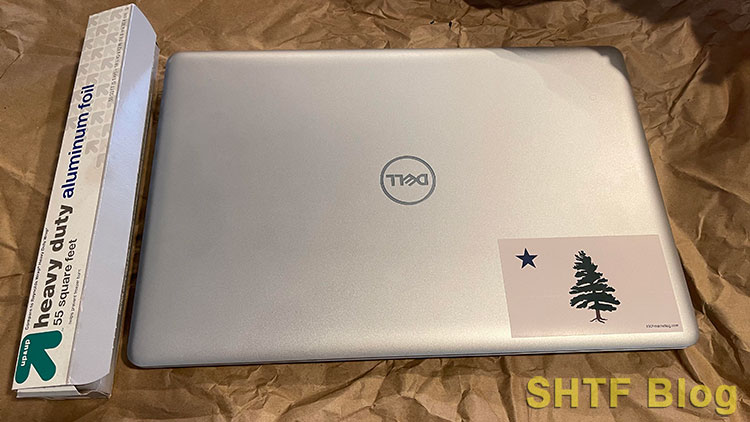
The method is simple:
- Wrap the computer in an insulating layer of material that does not conduct electricity.
- Tape it tight.
- Wrap it in at least 2 layers of heavy duty aluminum foil.
- Tape it tight.
Insulating Layer
The paper is there to create an insulating layer between the laptop and the aluminum foil. It’s important to create a layer between the two otherwise the foil might end up acting like an antenna that’s attracting an EMP charge.
I used brown packaging paper that came from an Amazon box, but you could use other materials. You could use a cardboard box, paper bag, wax paper, cloth, etc.

Protective Layer
Your protective layer is heavy duty aluminum foil. You can in the first picture that I used some “heavy duty” aluminum foil that we had in the house from Target. I can’t swear by the thickness of it, but I can tell you that it does not feel as heavy duty as Reynolds Wrap brand heavy duty does.

Reynolds Wrap brand is what I use when I’m wrapping food to cook on the grill or setting in the coals of an open fire. It’s rugged stuff, and if I was buying aluminum foil solely for purposes of protecting a computer, that’s what I’d buy.
You can replicate this process for a desktop PC. You just need more materials of each. For that matter, this approach can be used for any electronic device.
Method 2 – Laptop Faraday Sleeve
My preferred method is to buy an off-the-shelf Faraday sleeve. These are faster, more reliable, and more convenient than wrapping a device in aluminum foil.
Mission Darkness sells a variety of EMP-protection equipment, and it’s where my laptop sleeve came from. They market the product as a:
Military-grade faraday bag designed for law enforcement forensic investigators and armed services to shield electronic devices from RF signals; also used for executive travel, personal security, and EMP protection
Mission Darkness product page
While not explicitly marketed to preppers, it’s the perfect solution for someone looking to protect their laptop from an EMP strike.
We’ve reviewed their Faraday utility bag and Faraday phone sleeve before. It’s a company I feel comfortable promoting because I’ve seen their products firsthand and communicate regularly with the company. They’re based in the U.S. and also supply products to the government.
If you shop Mission Darkness, use coupon code “SHTFBLOG” for an additional 5% off.
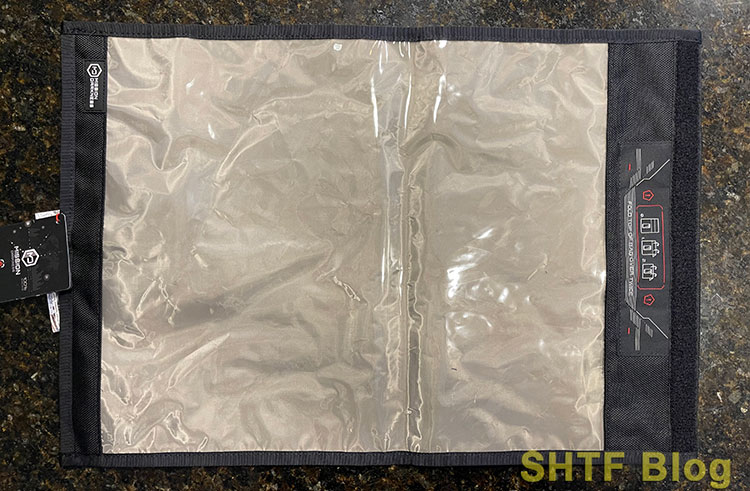
This product is going to cost more than wrapping a computer in paper and aluminum foil, but it’s far more convenient and suitable for storing your laptop safely inside every night. It’s also convenient for travel. I put my laptop in it when I travel through airports and to other countries.

The bag is made from from water-resistant ballistic nylon outer material and lined with Faraday fabric on the inside.
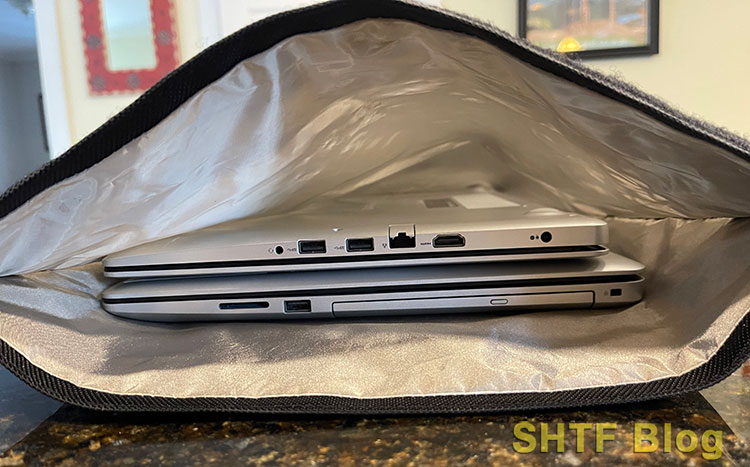
Mission Darkness sells 2 versions of this Faraday sleeve, one with a transparent window and the other without. They’re both the same price.
I have the window version, which I have, has a transparent “window” constructed of high-shielding Faraday fabric. The window allows you to view the devices inside, ensure the signal is cut off, and check battery life.
In the picture below I activated my phone screen and set it inside so you can see the transparency. It’s not a perfect window in that you can see fine details, but when a screen is lit up it’s easy to check that the bag is working as it’s supposed to by checking the signal.
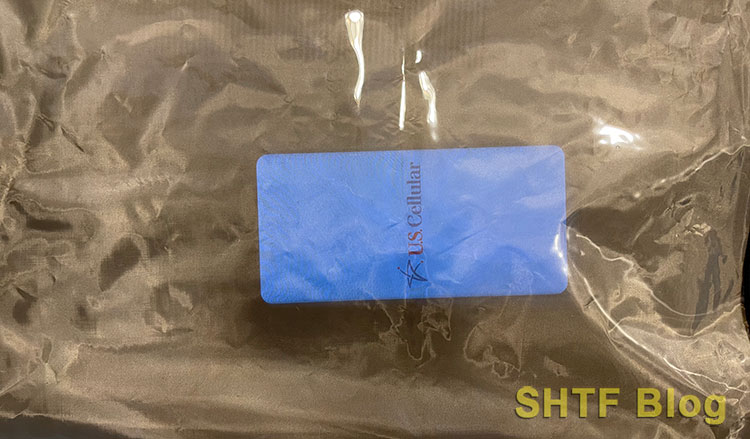
The bag is sealed by overlapping the end twice and securing it with the NeoLok closure system similar to heavy-duty Velcro. The will block all signals, including WiFi, Bluetooth, cell signals (including 5G), GPS, RFID, NFC, and radio signals with 90dB average attenuation.
If you want to explore other products they offer, consider these:
| Product | Retailer Link(s) |
|---|---|
| Non-Window Faraday Bag for Phones | Mission Darkness and Amazon |
| Faraday Tablet Sleeve | Mission Darkness |
| Faraday Window Bag for Laptops | Mission Darkness |
| Faraday Duffel Bag with MOLLE | Mission Darkness and Amazon |
| Faraday Backpack | Mission Darkness and Amazon |
| Faraday Car Cover (the Mothership product) | Mission Darkness |
Remember to use coupon code “SHTFBLOG” for an additional 5% off.
Summary
Protecting a valuable computer is just one measure you should take against and EMP. I have also suggested 7 other ways you can survive an EMP, because getting through the aftermath of an EMP strike is going to be much harder than just protecting a computer.
Know that if the attack was successful and widespread, society could break down in very short order. We could very well heading into a world without the rule of law.
Want to read more? Consider a copy of the Report of the Commission to Assess the Threat to the United States from Electromagnetic Pulse (EMP) Attack.
- Used Book in Good Condition
- Infrastructures, Critical National (Author)
- English (Publication Language)
- 200 Pages - 09/03/2011 (Publication Date) - PrepperPress.com (Publisher)

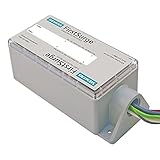



2 comments
I am reading the report you suggested to download (133pgs). I am wondering about Apartment EMP Surge protection for my computer, printer, television, wifi, internet router, cell phone and the needed charger for all. Perhaps an EMP protector that can protect all electronics devices in the apt. Plug & Play (into the outlets )so to speak. Since I don’t own the apt I don’t have permission to put in a fuse panel Surge protector. Not being an electrician I wouldn’t know how even if I had the permission to and could. Then also how strong of a surge protector? I have read something about up to 1GHZ. humm. I do have a small surge protector that I bought from someplace. It is a 6 plug in Belkin (the brand). Thank you Sincerely Jack
Hi, Jack. I removed your email address from your comment for your own spam protection. A surge protector will help, but it’s low-level protection. It’s going to be hard to FULLY protect your devices without putting them in a Faraday cage.